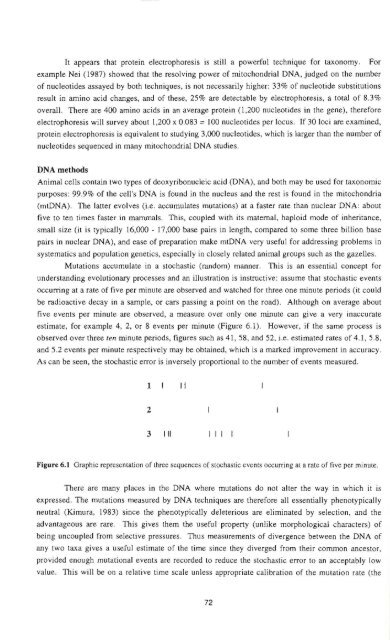CONSERVATION OF ARABIAN GAZELLES - Nwrc.gov.sa
CONSERVATION OF ARABIAN GAZELLES - Nwrc.gov.sa
CONSERVATION OF ARABIAN GAZELLES - Nwrc.gov.sa
You also want an ePaper? Increase the reach of your titles
YUMPU automatically turns print PDFs into web optimized ePapers that Google loves.
It appears that protein electrophoresis is still a powerful technique for taxonomy. For<br />
example Nei (1987) showed that the resolving power of mitochondrial DNA, judged on the number<br />
of nucleotides as<strong>sa</strong>yed by both techniques, is not neces<strong>sa</strong>rily higher: 33% of nucleotide substitutions<br />
result in amino acid changes, and of these, 25% are detectable by electrophoresis, a total of 8.3 %<br />
overall. There are 400 amino acids in an average protein (1 ,200 nucleotides in the gene), therefore<br />
electrophoresis will survey about 1,200 x 0.083 ~ 100 nucleotides per locus. If 30 loci are examined,<br />
protein electrophoresis is equivalent to studying 3,000 nucleotides, which is larger than the number of<br />
nucleotides sequenced in many mitochondrial DNA studies.<br />
DNA methods<br />
Animal cells contain two types of deoxyribonucleic acid (DNA), and both may be used for taxonomic<br />
purposes: 99.9% of the cell's DNA is found in the nucleus and the rest is found in the mitochondria<br />
(mtDNA). The latter evolves (i.e. accumulates mutations) at a faster rate than nuclear DNA: about<br />
five to ten times faster in mammals. This, coupled with its maternal, haploid mode of inheritance,<br />
small size (it is typically 16,000 - 17,000 base pairs in length, compared to some three billion base<br />
pairs in nuclear DNA), and ease of preparation make mtDNA very useful for addressing problems in<br />
systematics and population genetics, especially in closely related animal groups such as the gazelles.<br />
Mutations accumulate in a stochastic (random) manner. This is an essential concept for<br />
understanding evolutionary processes and an illustration is instructive: assume that stochastic events<br />
occurring at a rate of five per minute are observed and watched for three one minute periods (it could<br />
be radioactive decay in a <strong>sa</strong>mple, or cars passing a point on the road). Although on average about<br />
five events per minute are observed. a measure over only one minute can give a very inaccurate<br />
estimate, for example 4, 2, or 8 events per minute (Figure 6.1). However, if the <strong>sa</strong>me process is<br />
observed over three ten minute periods, figures such as 41 , 58, and 52, i.e. estimated rates of 4.1, 5.8,<br />
and 5.2 events per minute respectively may be obtained, which is a marked improvement in accuracy.<br />
As can be seen, the stochastic error is inversely proportional to the number of events measured.<br />
1 II<br />
2<br />
3 III I I I<br />
Figure 6.1 Graphic representation of three sequences of stochastic events occurring at a rate of five per minute.<br />
There are many places in the DNA where mutations do not alter the way in which it is<br />
expressed. The mutations measured by DNA techniques are therefore all essentially phenotypically<br />
neutral (Kimura, 1983) since the phenotypically deleterious are eliminated by selection, and the<br />
advantageous are rare. This gives them the useful property (unlike morphological characters) of<br />
being uncoupled from selective pressures. Thus measurements of divergence between the DNA of<br />
any two taxa gives a useful estimate of the time since they diverged from their common ancestor,<br />
provided enough mutational events are recorded to reduce the stochastic error to an acceptably low<br />
value. This will be on a relative time scale unless appropriate calibration of the mutation rate (the<br />
72
















